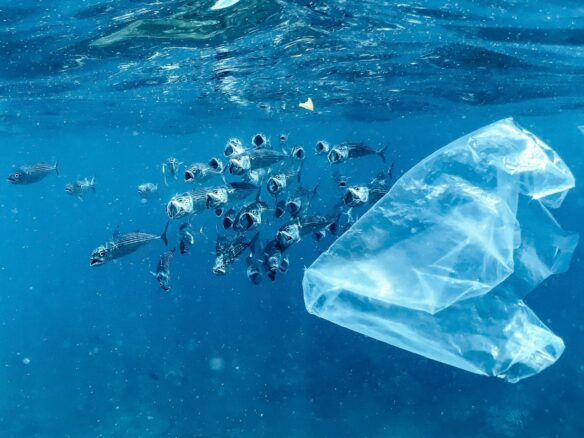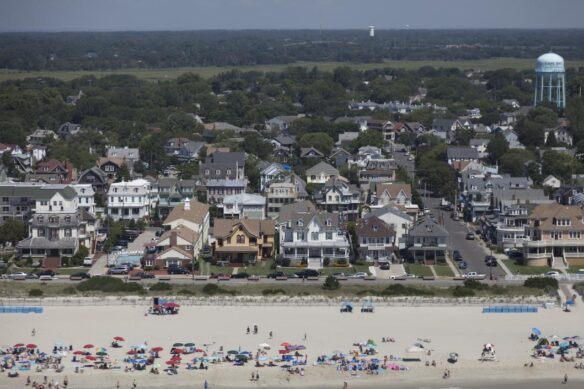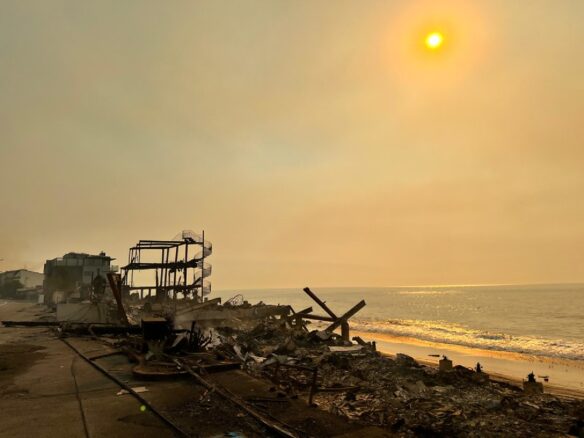Excerpt:
California is a place of magnificent tectonic forces that lift mountains only for them to be constantly eroded by glaciers, wind and rain, ground down to one of the most basic commodities on Earth: sand.
Sand covers our deserts, creates our foothills and fills our arroyos. It blankets the shores and piles into towering dunes. It’s everywhere.
So why are Californians fighting one another for it?
The sand wars are being waged up and down the coast on levels both micro and macro, as beachgoers, neighbors and cities quarrel over their share of a seemingly infinite resource. As beaches shrink, lines are now literally being drawn in the sand.
The situation has gained urgency in recent decades, as rising seas and coastal development derailed the normal cycles of sand replenishment. The U.S. Geological Survey estimates that California could lose up to 75% of its beaches in the next 75 years.
In July, a Laguna Beach homeowner went viral on TikTok after screaming at a family to get off what she wrongfully claimed was her property and hastily installing a rope barricade to block off the section of sand in front of her home.
“Karen of the week,” said the woman filming the video.
Shortly after, the California Coastal Commission hit the homeowner with a violation notice for harassing beachgoers, ordering her to remove the rope barrier from the beach or face a fine of $11,000 per day.
On the beach, fights in the sandbox come with big lawyers and big buckets.
In Malibu, the ultra-wealthy are fighting it out in the enclave of Broad Beach. Business titan James Kohlberg is suing his neighbor, billionaire Mark Attanasio, for allegedly stealing sand from the beach with excavators.
Kohlberg’s lawsuit accuses Attanasio, who owns the Milwaukee Brewers, of scooping up public sand and carrying it back to his property as part of a construction project.
Broad Beach — where houses hover just above the water, propped up on deteriorating seawalls bashed by crashing waves — needs all the sand it can get.
“It does get a little awkward being so close to the houses,” said Maggie Taylor, who lies out on Broad Beach every few weeks during the summer. “Depending on where the tide is, I can end up a few feet away from someone’s property.”
Taylor said she doesn’t want to invade anyone’s privacy, but she knows the beaches are for everyone to enjoy. And she doesn’t mind exercising that right.
That hasn’t stopped the rich from trying to block access, going as far as painting fake garage doors or posting false “No Parking” signs to dissuade beachgoers from parking near their properties.
But as the ocean slowly reclaims the sand in Broad Beach, a factor even more critical than pesky sunbathers is at play for homeowners: real estate values.
Over the last few decades, Malibu has emerged as one of the priciest communities in the country — primarily on the beach. Oakley founder James Jannard set a California price record when he sold his Malibu beach house for $210 million. Yet just two miles inland, a plot of land is currently available for $179,000.
What happens to a beach house when there’s no more beach?
Erosion has become such a problem in Broad Beach that high-profile residents such as Dustin Hoffman, Ray Romano and Pierce Brosnan committed their own money to a $31-million restoration project to bolster the beach’s sand and protect the value of the community’s 121 parcels, many of which were purchased for $20 million or more.
The resident-funded initiative involves trucking in sand from quarries in Simi Valley and Moorpark.
It’s a high price tag for a short-term solution, according to Brett Sanders, a professor of civil and environmental engineering at UC Irvine. Sanders said sand costs about $30 per cubic yard to ship. A modest nourishment would be about 100,000 cubic yards — so roughly $3 million.
But how long does the new sand last? It depends. A 1960s nourishment of Capistrano Beach in Orange County lasted for about two decades before thinning out, Sanders said. But some projects last only a matter of months before the fresh sand is pulled back into the water.
According to Sanders, however, that’s not such a bad thing.
“When sand gets pulled under, it refills the coastal area near the shore. Sand has to be under and above the water for a beach to be healthy,” he said. “Small amounts of sand go under quickly, but the more we have, the more the beach recovers.”
Sand flowing in and out of beaches is a natural process. It typically flows in through rivers, but that has been slowed down by dams designed to hold back sediment. It also comes from cliff erosion, but that has also stopped in some areas as Southern Californians cram houses onto cliffs and stabilize the slopes so their homes don’t careen into the sea.
It flows out by the force of heavy waves and strong rip currents, which drag sand off the beach, where it is transported by deeper currents laterally up and down the coast. Gentler waves bring the sand back to shore, which is why the beaches grow during the calmer seas of summer. But the currents are kingmakers, stealing mountains of sand away from some beaches and dropping it off at others.
That’s part of the reason why some Orange County beaches are suffering while others, such as Huntington Beach, are growing by roughly 3 feet each year.
“Solutions require a collective mindset where your project might help the beach next to you,” Sanders said. “Sand is shared, and it takes coordination across communities.”
Easier said than done for some California cities…









